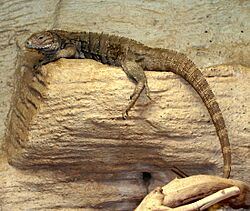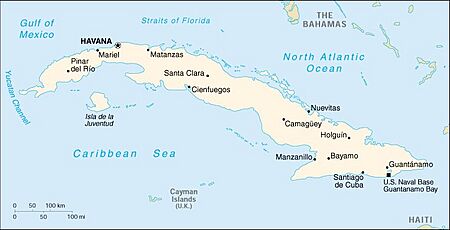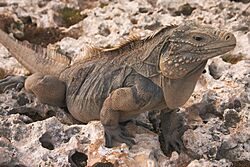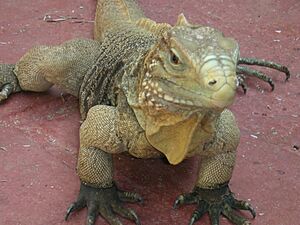Cuban rock iguana facts for kids
Quick facts for kids Cuban rock iguana |
|
|---|---|
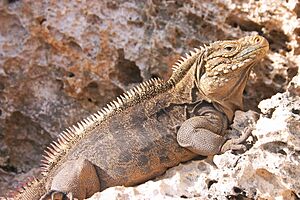 |
|
| Cyclura nubila | |
| Conservation status | |
| Scientific classification | |
| Genus: |
Cyclura
|
| Species: |
nubila
|
| Subspecies | |
|
|
The Cuban rock iguana (Cyclura nubila) is a large lizard found in the Caribbean. It is also known as the Cuban ground iguana or Cuban iguana. This amazing reptile is the second largest of the West Indian rock iguanas. These iguanas are a group of lizards that are very endangered.
Cuban iguanas are mostly plant-eaters. They have thick tails and spiky jowls. You can find them all over Cuba and its smaller islands. There's even a wild group living on Isla Magueyes in Puerto Rico. A special kind of Cuban iguana lives on the Cayman Islands.
Female iguanas protect their nests. Some even nest in holes dug by Cuban crocodiles! To stay safe, Cuban iguanas often live near spiky prickly-pear cacti.
Scientists and conservation groups have worked hard to help these iguanas. They have started programs to breed them in zoos. These efforts have helped increase their numbers. Studying the Cuban iguana has also helped us learn about evolution and how animals communicate.
Contents
Understanding Cuban Iguanas
How Scientists Name Animals
Scientists give every animal a special name, like Cyclura nubila for the Cuban iguana. This helps everyone know exactly which animal they are talking about. The first scientist to describe this iguana was Edward Griffith in 1831. He called it Lacerta nebulosa. Later, John Edward Gray gave it the name Iguana (Cyclura) nubila. The word nubila means "cloudy" in Latin.
Over time, scientists have learned more about these iguanas. They use DNA to figure out how different iguana species are related. For example, the Cuban iguana is closely related to the blue iguana from Grand Cayman. It's also related to the Northern Bahamian rock iguana.
Cuban Iguana Family Tree
Scientists once thought the Cuban iguana had three different types, called subspecies. These included the Grand Cayman blue iguana, the Lesser Caymans iguana, and the main Cuban iguana. But now, the Grand Cayman blue iguana is considered its own separate species. This is because DNA studies showed it was different enough.
Scientists continue to study the genes of Cuban iguanas. They've found that iguanas from eastern and western Cuba have some differences in their DNA. This might be because Cuba was once two separate islands millions of years ago.
What Cuban Iguanas Look Like
The Cuban iguana is a very large lizard. Only the blue iguana is bigger among the Cyclura family. An adult Cuban iguana's body, from its snout to the base of its tail, is about 40 centimeters (16 in) long. Some males can be much longer, reaching up to 1.6 meters (5.2 ft) from snout to tail tip! Females are usually about two-thirds the size of males.
Male and female Cuban iguanas look a bit different. This is called sexual dimorphism. Males are much bigger. Their skin can be dark gray or brick red. Females are usually olive green with dark stripes. Both have black limbs with pale brown spots and black feet.
Young iguanas are often dark brown or green. They have faint stripes that fade as they get older. Both male and female iguanas have a dewlap, which is a flap of skin under their neck. They also have a row of spines running down their back to their thick tail. Their heads are short and strong, and their jaws are powerful. Their jowls get spikier as they age.
Cuban Iguana Life and Habits
What They Eat
Cuban iguanas are mostly plant-eaters. They munch on plants like purslane, prickly pear cacti, and black mangrove. They also eat different types of grasses. Sometimes, they might eat small animals like birds, fish, or crabs. Once, a scientist saw an adult female iguana chase and eat a baby iguana. This was unusual and might happen when there are too many iguanas in one area.
Mating and Behavior
Cuban iguanas are ready to have babies when they are two or three years old. Young males get along well, but older males become more aggressive. They fight to protect their areas and find mates. Females are more friendly with each other, except when they have just laid eggs.
Mating happens in May and June. Females lay their eggs in June or July. They usually lay between three and 30 eggs at a time. Female iguanas often use the same nesting spots every year. Sometimes, they even use holes dug by Cuban crocodiles! These nesting spots are important because there aren't many good places to lay eggs.
Baby iguanas stay in the nest for a few days to two weeks after hatching. Then, they leave the nest on their own. Adult female iguanas guard their nests. They might shake their heads or hiss at anyone who gets too close.
Even though Cuban iguanas usually move slowly, they can run very fast for short distances. Younger iguanas like to climb trees and are very good at it. If they feel threatened, they can swim well in water. If they are cornered, they can bite or lash their tails to defend themselves.
Where Cuban Iguanas Live
Cuban iguanas live in rocky areas along the coast of Cuba. They also live on many of the 4,000 small islands around Cuba. One of the largest groups lives on Isla de la Juventud. You can find them in protected areas on the mainland too.
A large group of iguanas lives on the US Naval Base at Guantánamo Bay. There are about 2,000 to 3,000 iguanas there. The US forces protect these animals. People who work at the base often get to know these "prehistoric-looking giants."
The special type of Cuban iguana, C. n. caymanensis, lives only on Little Cayman and Cayman Brac. There are fewer than 50 of these iguanas on Cayman Brac, but about 1,500 on Little Cayman. Some of these iguanas have also started living wild on Grand Cayman.
Cuban iguanas often dig their burrows near cacti or thistles. Sometimes, they even live inside a cactus! These spiky plants offer protection and provide food like fruit and flowers. In places without cacti, iguanas make their homes in dead trees, hollow logs, or cracks in limestone rocks.
In the 1960s, a small group of Cuban iguanas was released from a zoo onto Isla Magueyes in Puerto Rico. They formed a wild population there. This group has become the source for most of the Cuban iguanas kept in private collections today. Scientists have studied these iguanas to learn about how animal communication can change quickly over generations.
Protecting Cuban Iguanas
The Cuban government protects most of the main iguana populations. While there isn't a breeding program in Cuba yet, they are thinking about starting one. In 1985, Cuba even put a Cuban iguana on a special coin to help people learn about and protect the animal.
Many zoos and private owners have Cuban iguanas in their breeding programs. This helps reduce the need to take iguanas from the wild for the pet trade. The Cuban iguana is listed as "vulnerable" on the IUCN Red List. This means they could become endangered if we don't protect them. The type of iguana from the Cayman Islands is even more endangered, listed as "critically endangered."
There are about 40,000 to 60,000 Cuban iguanas in Cuba. The wild group on Isla Magueyes has over 1,000 iguanas.
One big threat to iguanas in the Caribbean is cats. On Guantanamo Bay, cats eat many baby iguanas every year.
In 1993, the San Diego Zoo started a special program called "head-starting" for baby Cuban iguanas. In this program, iguana eggs are hatched in an incubator. The baby iguanas are then protected and fed for about 20 months. The goal is to help them grow big enough to escape or fight off predators. This method was first used for sea turtles.
The "head-starting" program worked well for Cuban iguanas. The iguanas released into the wild acted like other wild iguanas. They found food and reacted to predators normally. This strategy has been very successful for other endangered iguanas in the Caribbean and Central America.



